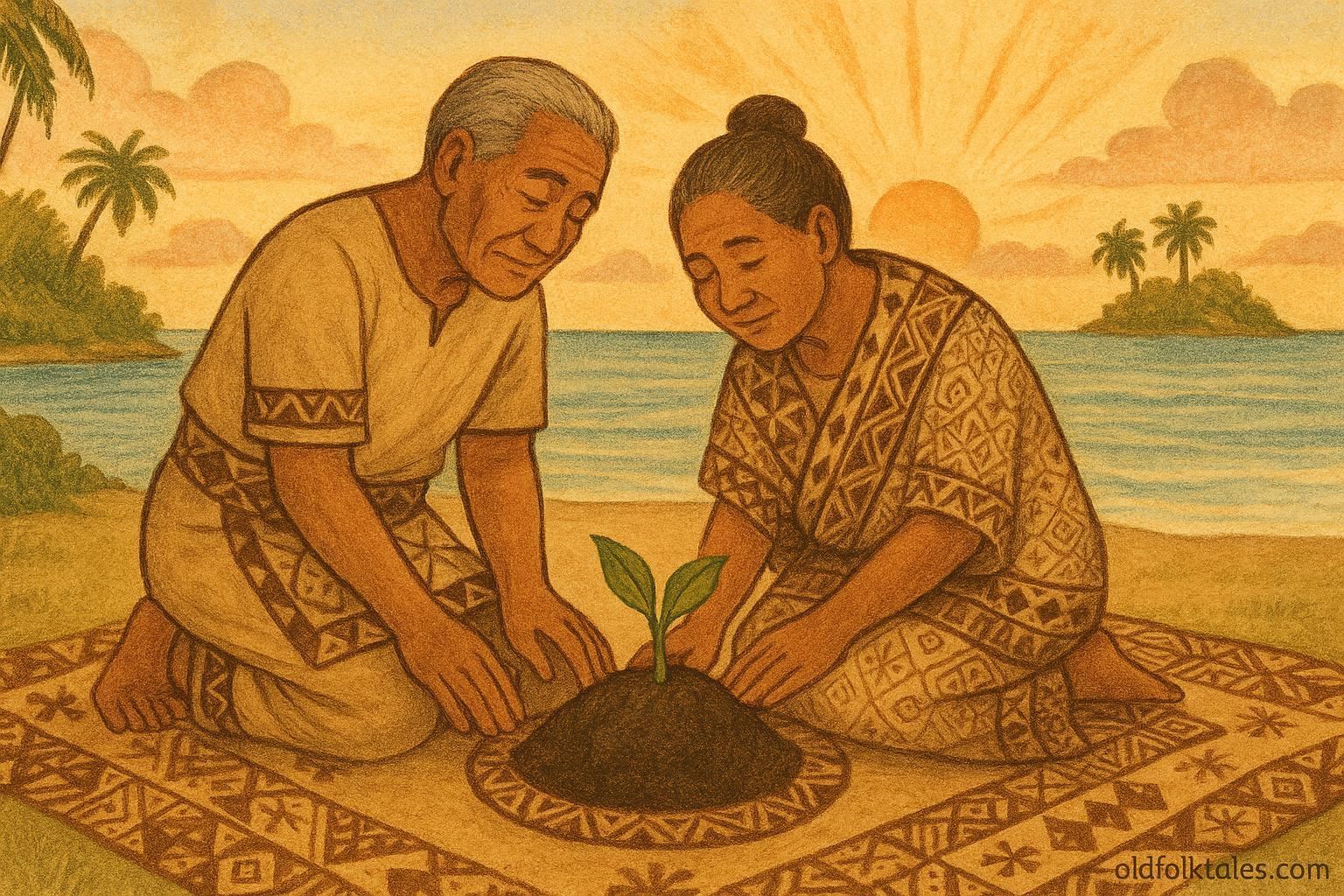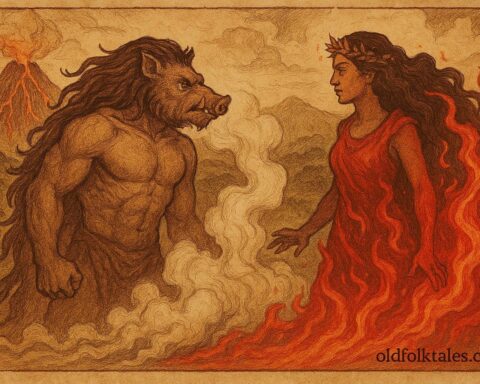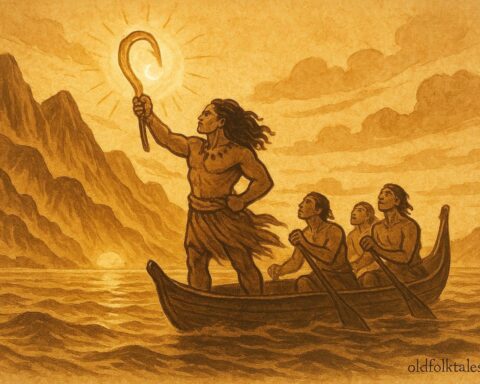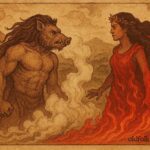Long ago, when the first kings of Tonga ruled over the scattered islands of the sea, there lived a poor couple named Fevanga and Fefafa. Their home stood on the quiet island of ‘Eua, where the morning mists drifted over green hills and the call of seabirds echoed between the palms. Though their house was small and their garden yielded little, peace and kindness filled their hearts. Their greatest treasure was their daughter, Kava, a gentle child whose laughter brightened even the leanest days.
But the time came when the heavens grew silent. The rains ceased, the streams dried to dust, and the crops shriveled beneath the burning sun. The great famine spread across the islands like a shadow. The taro withered, the yams cracked, and even the coconuts, the food of last resort, hung empty and dry. The people prayed to the gods of sky and sea, but their voices went unanswered.
Fevanga and Fefafa, though poor, shared what little they had with their neighbors. Sometimes it was only a single coconut or a handful of dry roots, but they believed that kindness was a greater nourishment than food. Yet each day, they saw their daughter grow thinner, her once bright eyes dimmed by hunger.
One evening, as the sun sank into the horizon and painted the waves in fire, Fevanga dreamed. In his dream, a great voice rolled from the heavens like thunder:
“Your devotion is known, Fevanga. A gift must be given, a gift pure and without equal. From your sorrow will spring peace for your people.”
When Fevanga awoke, his heart was heavy. He told Fefafa what he had seen, and she wept silently. She looked upon their sleeping child and knew the meaning of the dream. “Our Kava,” she whispered, “is the offering the gods desire.”
At dawn, they told their daughter what had been revealed to them. Tears fell freely from their eyes, but Kava, though young, understood the depth of their love and the greatness of their duty. She placed her small hands upon theirs and said, “If my life will bring life to our people, then I go with peace. Let my spirit return to the earth that it may feed all who hunger.”
When the morning tide rose high, the villagers gathered on the shore to welcome the Tu‘i Tonga, the sacred king and descendant of the gods, who had come to bless the islands and offer prayers for the famine’s end. The people brought gifts, woven mats, shells, fish, but Fevanga and Fefafa had nothing. They stood apart, trembling with grief, holding their daughter close for the last time.
Before the king, they knelt and told their story. “We have no riches to offer,” Fevanga said, his voice shaking. “Only this, our child, whom we give in love for Tonga.”
The Tu‘i Tonga, hearing their words, was struck with sorrow. He looked upon the girl, whose calm face shone with the serenity of the gods, and he wept. “No greater gift could be given,” he said. “From such love, the heavens themselves may find mercy.”
The couple laid Kava to rest on a small mound by the sea, beneath a cluster of pandanus trees. The sand shimmered beneath the morning light as they covered her with earth and flowers. The people stood in silence, their hearts heavy with awe and grief. The king raised his hands to the sky and prayed that her spirit would be received by the divine ancestors.
That night, clouds gathered for the first time in many months. The sky darkened, and the wind carried the scent of rain. When dawn broke, the heavens opened, and the rain fell gently upon the island, cool, cleansing, endless. The thirsty earth drank deeply. The rivers came alive again, and the people rejoiced.
Days later, two green shoots appeared from the mound where Kava had been buried. One had broad, heart-shaped leaves, and the other rose in tall, thin stalks. The villagers watched them grow, astonished. The Tu‘i Tonga’s priests came and examined the plants. When the broad-leafed one matured, they discovered that its roots could be ground and mixed with water to make a drink that calmed the mind and softened anger. The other plant, a kind of sugarcane, brought sweetness and vitality when chewed.
The king named the first plant “kava,” after the girl whose sacrifice had made it possible, and the second plant “to,” for balance and renewal. He declared both to be sacred gifts from the gods, born from the purity of a human heart.
In time, a great ceremony was held. The Tu‘i Tonga sat before a polished wooden bowl carved for the sacred drink. The priests prepared the first brew, crushing the kava root and straining it through fiber while chanting ancient words of peace. The liquid was poured into a cup made from a polished coconut shell and offered first to the king, then to the chiefs, and finally to the people.
As the drink passed from hand to hand, a gentle stillness spread among them, a calm that felt like harmony with the world itself. They said it was as though Kava’s spirit moved among them, bringing comfort and peace.
From that time onward, every royal feast and sacred ceremony began with the kava ritual. It became the drink of unity, respect, and remembrance, connecting chiefs, families, and ancestors across generations. Even today, when the first cup of kava is lifted, the people speak softly of the girl from ‘Eua, whose love became the life of Tonga.
Thus, from sorrow grew blessing, and from death came life. The sacred kava plant stands as a living reminder that the truest devotion lies not in wealth or power, but in selfless love.
Discover the adventures of Māui, Pele, and Tangaloa in the timeless Polynesian oral tradition
Moral Lesson
True sacrifice comes from love, not obligation. The story of Kava teaches that even in times of despair, compassion and faith can transform tragedy into lasting peace. Her spirit reminds us that unity, respect, and remembrance sustain a people far more than wealth ever could.
Knowledge Check (Q&A)
- What is the Origin of the Kava Plant in Tongan mythology?
It comes from the sacrifice of a young girl named Kava, whose grave gave birth to the sacred kava root. - Who were Kava’s parents in the legend?
Fevanga and Fefafa, a poor but devoted couple from the island of ‘Eua. - Why did Fevanga and Fefafa sacrifice their daughter?
They wished to offer the greatest possible gift to the Tu‘i Tonga during a famine, believing her sacrifice would bless their people. - What grew from Kava’s grave?
Two plants, kava, the sacred root used in rituals, and to, a variety of sugarcane symbolizing sweetness and renewal. - What does kava symbolize in Tongan culture?
Peace, unity, respect, and the spiritual connection between humans and the divine. - How is kava used today in Tonga?
It remains central in royal and communal ceremonies as a symbol of harmony, remembrance, and sacred tradition.
Source: Tongan Myths and Legends by E. E. V. Collocott (1921)
Cultural Origin: Tonga (Ha‘apai Islands, Polynesia)












